
Palazzo Mozzi or Palazzo de' Mozzi is an early Renaissance palace, located at the end of the Piazza de' Mozzi that emerges from Ponte alle Grazie and leads straight to the palace where via San Niccolò becomes via de' Bardi in the Quartiere of Santo Spirito in the Oltrarno section of Florence, region of Tuscany, Italy. The 13th-century palace housed the gallery of the highly successful antiquarian Stefano Bardini, of which the remnants were left to the commune, where they assembled the Museo Bardini or Mozzi Bardini, displaying Florentine art and artifacts up to the early Renaissance. The gardens elaborated against the hillside behind the palace were added mainly by Bardini.

Palazzo Borghese is a palace in Rome, Italy, the main seat of the Borghese family. It was nicknamed il Cembalo due to its unusual trapezoidal groundplan; its narrowest facade faces the River Tiber. The entrance at the opposite end of the building, the "keyboard" of the cembalo, faces onto the Fontanella di Borghese, with another in a great flanking facade to the Piazza Borghese that is extended by a slightly angled facade leading down Via Borghese towards the river. Both these entrances lead into a large courtyard on one side of which is a two level open arcade, with paired Doric and Ionic columns, that frames the garden beyond.
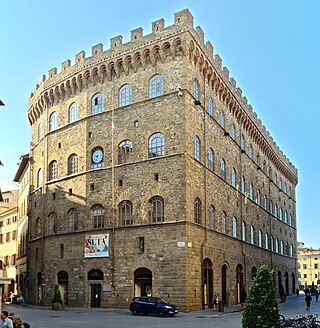
Palazzo Spini Ferroni is a large Gothic palace located along Via de' Tornabuoni at the corner of Piazza Santa Trinita, in central Florence, Tuscany, Italy. It stands across from the church of Santa Trinita.

Piazza della Repubblica is a city square in Florence, Italy. It was originally the site of the city's forum; then of its old ghetto, which was swept away during the improvement works, or Risanamento, initiated during the brief period when Florence was the capital of a reunited Italy—work that also created the city's avenues and boulevards. At that time, the Loggia del Pesce from the Mercato Vecchio was also moved to Piazza Ciompi. The square's Giubbe Rosse cafe has long been a meeting place for famous artists and writers, notably those of Futurism.
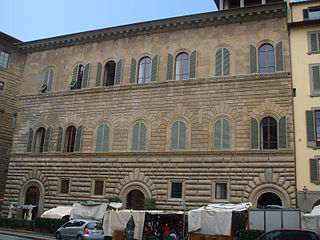
Palazzo Gondi is a palace in Florence, Italy, located a block from Piazza della Signoria. It was built in 1490 under design by Giuliano da Sangallo, who was inspired by other major works of stately buildings in the city, such as Palazzo Medici and Palazzo Strozzi. Among the elements borrowed from these earlier works are the cube-shape set around a central courtyard, the ashlar sloping on each of three floors, and the arched windows.
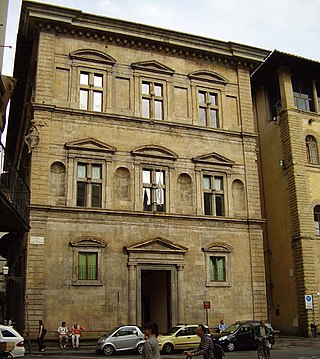
The Palazzo Bartolini Salimbeni is a High Renaissance-style palace located on Via de' Tornabuoni on Piazza Trinita in central Florence, Italy.
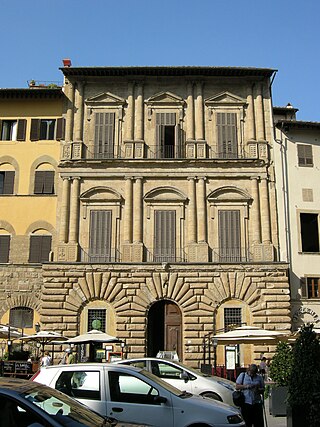
Palazzo Uguccioni is a Renaissance palace on the Piazza della Signoria in Florence, central Italy.
The Villa di Murlo is a rural palace or villa located in the hills surrounding San Casciano in Val di Pesa, on the old road between Florence and Siena that follows the Pesa River.

The Palazzo di Parte Guelfa is a historical building in Florence, central Italy. During the Middle Ages, it was the medieval headquarters of the Guelph party in the city. It stands across the alley from the Palazzo Canacci.

Palazzo Cocchi-Serristori is a Renaissance-style palace in Piazza Santa Croce, Florence, Italy. It presently houses offices of a regional council of Florence.

Palazzo dello Strozzino is a Renaissance palace in Florence, Italy. The stone Renaissance facade is located on Piazza degli Strozzi, diagonal to the Southeast corner of the imposing Palazzo Strozzi. The Northern façade on Via dei Anselmi houses the entrance to the Cinema Odeon.

Piazza d'Aracoeli is a square of Rome (Italy), placed at the base of the Capitoline Hill, in the Rione X Campitelli.

The Palazzo Tolomei is an imposing, Gothic style urban palace, located on Via Banchi di Sopra in the present contrada of Civetta, Terzo di Camollia of the city of Siena, region of Tuscany, Italy.

The Palazzo Spannocchi is a Renaissance style urban palace located on the Piazza Salimbeni, just off Via Banchi di Sopra in the Terzo di Camollia of the city of Siena, region of Tuscany, Italy. The building was associated with an ancient mercantile family of Siena.

The Palazzo Nasi, also known as the Palazzo Torrigiani or Palazzo Scarlatti, is a palace located at Piazza de' Mozzi 4, down the street where the Ponte alle Grazie enters the Oltrarno, in Florence, Tuscany, Italy. Another Palazzo Torrigiani Del Nero, with a Mannerist or late-Renaissance-style facade stands closer to the river. Both palaces also once belonged to the Nasi. The palace is a few steps from the Palazzo Mozzi.
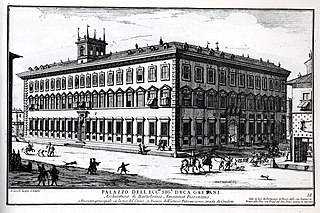
The Palazzo Ruspoli is a Renaissance-style, 16th century aristocratic palace located on Via del Corso 418, where Corso intersects with Largo Carlo Goldoni and the Piazza di San Lorenzo in Lucina, in the Rione IV of Campo Marzio in central Rome, Italy.

The Parte Guelfa Holy Family is a tempera on panel painting by Luca Signorelli, created c. 1490, now in the Uffizi in Florence.

Palazzo Bezzoli, or Del Bembo or Martelli, is a civic building in the historical centre of Florence, located between via dei Cerretani 11r-13r-15r-17r-19r and piazza dell'Olio 3. The palazzo appears in the list drawn up in 1901 by the General Directorate of Antiquities and Fine Arts, as a monumental building to be considered national artistic heritage (Italy).

Palazzo Acciaiuoli, also known as Palazzo Usimbardi' or Usimbardi-Acciaiuoli, is located in Borgo Santi Apostoli in the historical centre of Florence. It incorporates the older Torre degli Acciaiuoli, formerly dei Buondelmonti, located at the corner of Chiasso delle Misure. Today it houses a hotel.





















